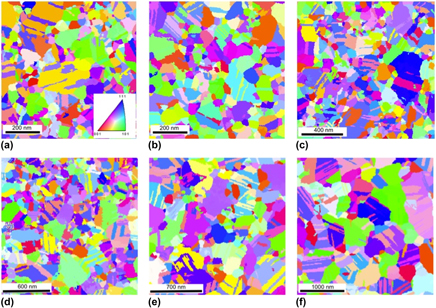Crossref Citations
This article has been cited by the following publications. This list is generated based on data provided by
Crossref.
Barmak, Katayun
Liu, Xuan
Darbal, Amith
Nuhfer, N. Thomas
Choi, Dooho
Sun, Tik
Warren, Andrew P.
Coffey, Kevin R.
and
Toney, Michael F.
2016.
On twin density and resistivity of nanometric Cu thin films.
Journal of Applied Physics,
Vol. 120,
Issue. 6,
Rohrer, Gregory S.
Liu, Xuan
Liu, Jiaxing
Darbal, Amith
Kelly, Madeleine N.
Chen, Xiwen
Berkson, Michael A.
Nuhfer, Noel T.
Coffey, Kevin R.
and
Barmak, Katayun
2017.
The grain boundary character distribution of highly twinned nanocrystalline thin film aluminum compared to bulk microcrystalline aluminum.
Journal of Materials Science,
Vol. 52,
Issue. 16,
p.
9819.
Ma, Huan
La Mattina, Fabio
Shorubalko, Ivan
Spolenak, Ralph
and
Seita, Matteo
2017.
Engineering the grain boundary network of thin films via ion-irradiation: Towards improved electromigration resistance.
Acta Materialia,
Vol. 123,
Issue. ,
p.
272.
Beyerlein, Irene J.
and
Arul Kumar, M.
2018.
Handbook of Materials Modeling.
p.
1.
Mao, Pengyan
Cui, Jingping
Chen, Yangchun
Qiu, Jianhang
Jin, Qun
Qiao, Jixiang
Zhao, Yang
Cui, Kan
Gao, Ning
and
Tai, Kaiping
2019.
Quantitative investigation on sink strength of nano-grain boundary for irradiation resistance.
Journal of Nuclear Materials,
Vol. 526,
Issue. ,
p.
151741.
Beyerlein, Irene J.
and
Arul Kumar, M.
2020.
Handbook of Materials Modeling.
p.
1313.
Kumar, Mariyappan Arul
and
Beyerlein, Irene J.
2020.
Local microstructure and micromechanical stress evolution during deformation twinning in hexagonal polycrystals.
Journal of Materials Research,
Vol. 35,
Issue. 3,
p.
217.
Li, J.X.
Shi, Y.-N.
You, Z.S.
and
Li, X.Y.
2021.
Tensile strain induced texture evolution in a Ni–Mo alloy with extremely fine nanotwinned columnar grains.
Materials Science and Engineering: A,
Vol. 812,
Issue. ,
p.
141108.
Lin, Yao
Han, Luyi
and
Wang, Guangchun
2022.
Coupling effect of torsion and electric pulse treatment on grain boundary regulation and plasticizing of nickel wire.
Materials Science and Engineering: A,
Vol. 857,
Issue. ,
p.
143747.
Robinson, Accalia
Verma, Akarsh
Homer, Eric R.
and
Thompson, Gregory B.
2023.
Nanotwin stability in alloyed copper under ambient and cryo-temperature dependent deformation states.
Materials Science and Engineering: A,
Vol. 871,
Issue. ,
p.
144866.
Lin, Yao
Han, Luyi
and
Wang, Guangchun
2023.
Relationship between Σ3 Boundaries, Dislocation Slip, and Plasticity in Pure Nickel.
Materials,
Vol. 16,
Issue. 7,
p.
2853.
dos Santos, Igor C.
Mazzer, Eric M.
Figueiredo, Roberto B.
Langdon, Terence G.
and
Pereira, Pedro Henrique R.
2023.
Evidence for two-stage hardening in an Al-Zn-Mg-Cu alloy processed by high-pressure torsion.
Journal of Alloys and Compounds,
Vol. 941,
Issue. ,
p.
168839.
Mao, Pengyan
Cui, Jingping
Cheng, Zhao
Yang, Lingling
Zhao, Hui
Li, Hongda
and
Tai, Kaiping
2023.
Coupling effects of W alloying with preparation temperature on microstructures and irradiation tolerance of nanostructured Cu films.
Vacuum,
Vol. 210,
Issue. ,
p.
111897.
